Go foraging for elderflowers, and then make this sparkling mead recipe! This easy homemade sparkling elderflower mead recipe is low alcohol, delicately flavored, and the perfect foraged drink for a hot summer day!
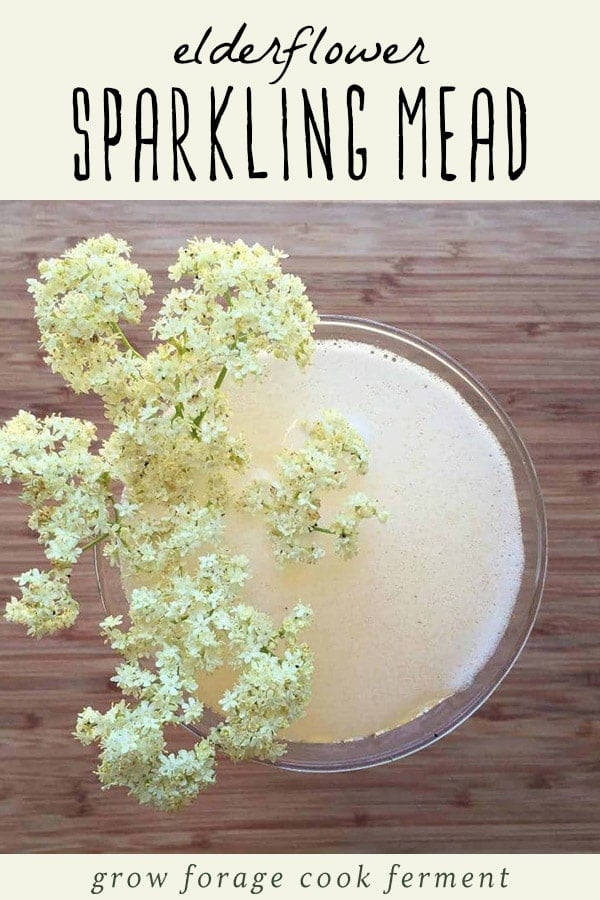
Want to save this post for later?
Simple Mead Making Ebook
Want to learn more about making mead? I have a Simple Mead Making for Beginners eBook just for you!
It has ingredient and equipment checklists and detailed instructions for brewing and bottling your mead, so be sure to check that out if you’re new to the mead making process.
Using Elderflowers for Mead
Ahh, early summer is upon us. This means wildflowers are in full force in most of the country. One of my very favorite flowers to work with is elderflowers, which will soon turn into beloved elderberries.
Later in the season, I love turning elderberries into elderberry mead and into a medicinal elderberry syrup.
Elderflowers have enough going for them, however, that it’s a worthwhile endeavor to collect them for some lovely, early summer elderflower treats like elderflower muffins or elderflower liqueur.
Just be sure that you leave plenty on the tree so that you get berries.
A lot of people make a cordial with their foraged elderflowers, which also sounds amazing, but I’m a mead girl. I made an awesome wildflower mead recently with dandelions, lavender, and yarrow, so I wanted to do something similar to that.
Elderflowers are so pretty and fragrant, but not overwhelmingly so. I decided to make a light, sparkling mead, similar to champagne, to complement their delicate flavor.
Related: 20+ Elderflower Recipes: cordial, liqueur, tea, jelly, cake + more!
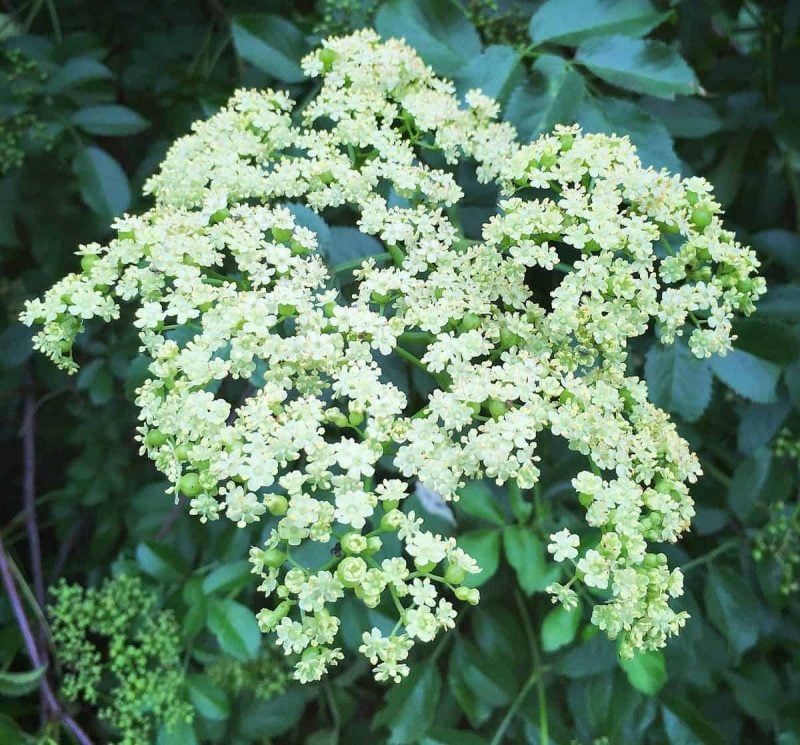
Get recipes using wild violet, lilac, forsythia, chive, calendula, lavender, white clover, nasturtium, elderflower, yarrow, rose, and Queen Anne’s lace flowers in my ebook Edible Flower Recipes: Infusions, Syrups, Jellies, Beverages, & Snacks!
Elderflower Sparkling Mead Recipe
To get every mead making step in detail, check out my How to Make a Gallon of Mead post. It will guide you along the entire process!
The very first step when making any homebrewed alcohol is to make sure that everything that will be used in the process is properly sanitized.
My favorite sanitizer to use, because it’s easy and non-toxic, is One Step.
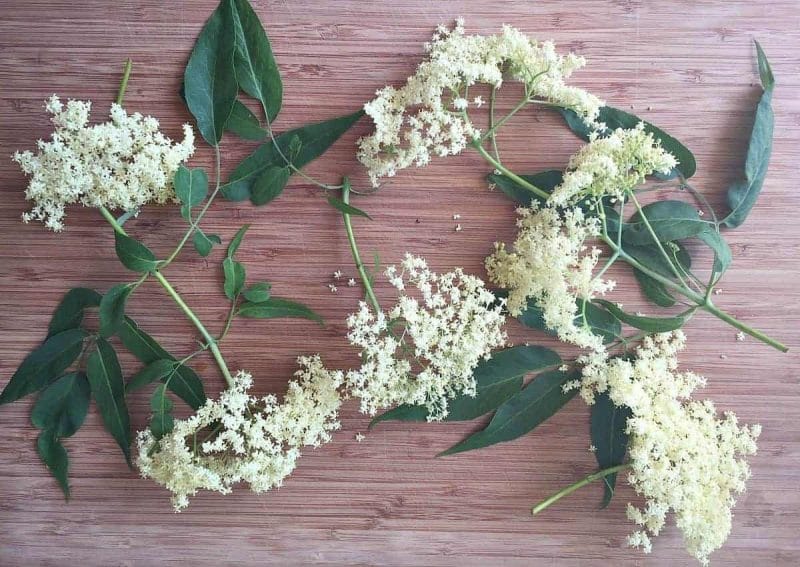
Brew the Elderflower Mead
After you’ve sanitized everything, the next step is to make a strong tea with the elderflowers.
I put about a half gallon of filtered water in a pot with the flowers, bring to a boil for about 2-3 minutes, then take off the heat and let steep.
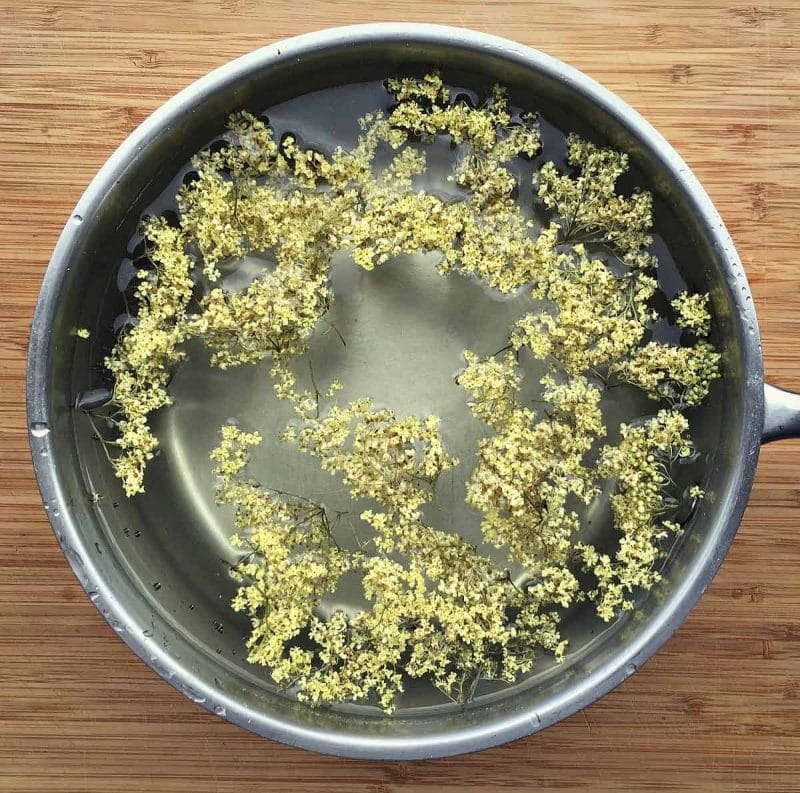
After the tea has cooled slightly, but is still warm, add the honey.
Since I wanted a lighter mead with a lower alcohol content, I only used 1.5 pounds of honey. This amount is adjustable up to 3 pounds of honey per gallon of mead depending on your taste.
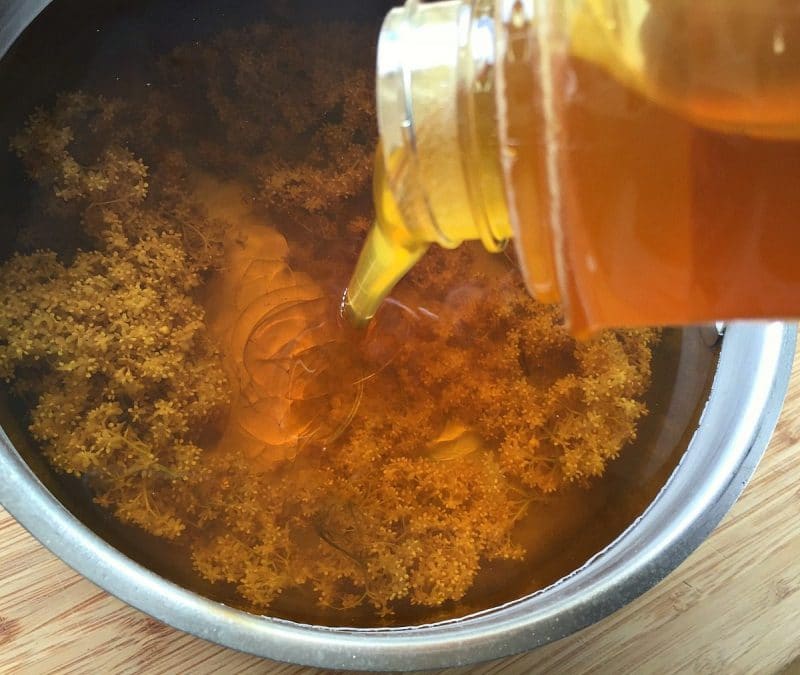
Once the tea is close to room temperature, use a funnel to add it to your fermenting vessel (this one gallon jug with airlock is perfect), flowers and all. You can strain the flowers out if you wish, but I like to leave them in to really get their essence.
Add the lemon juice and raisins, and fill the jug up with cool filtered water, leaving about 3 inches or so of head space at the top.
Pitch the Yeast & Ferment the Elderflower Mead
Add the champagne yeast, cap the jug, and give it a few good shakes to combine everything.
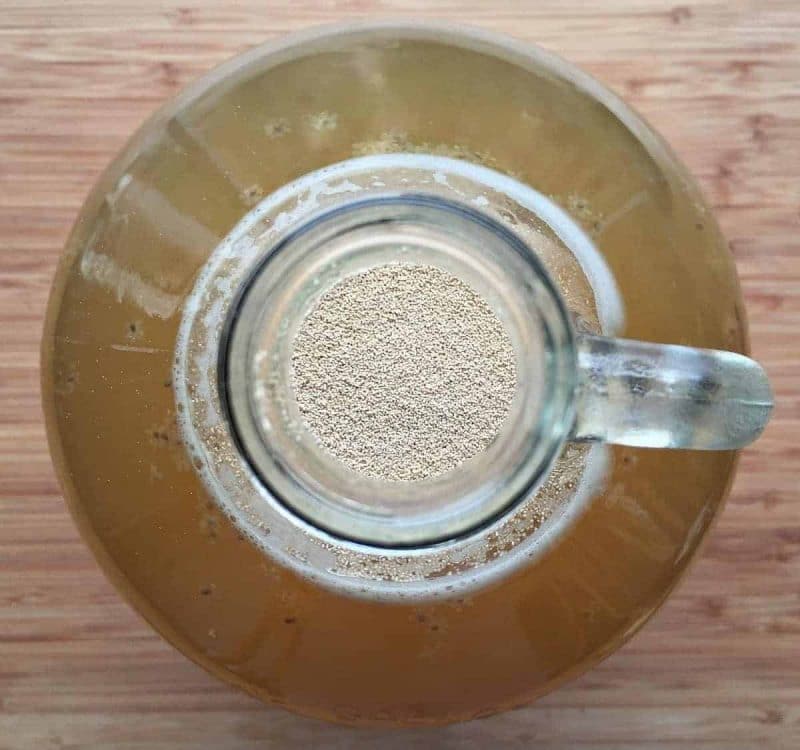
Remove the cap, fill the airlock with water to the line, then place it into the jug.
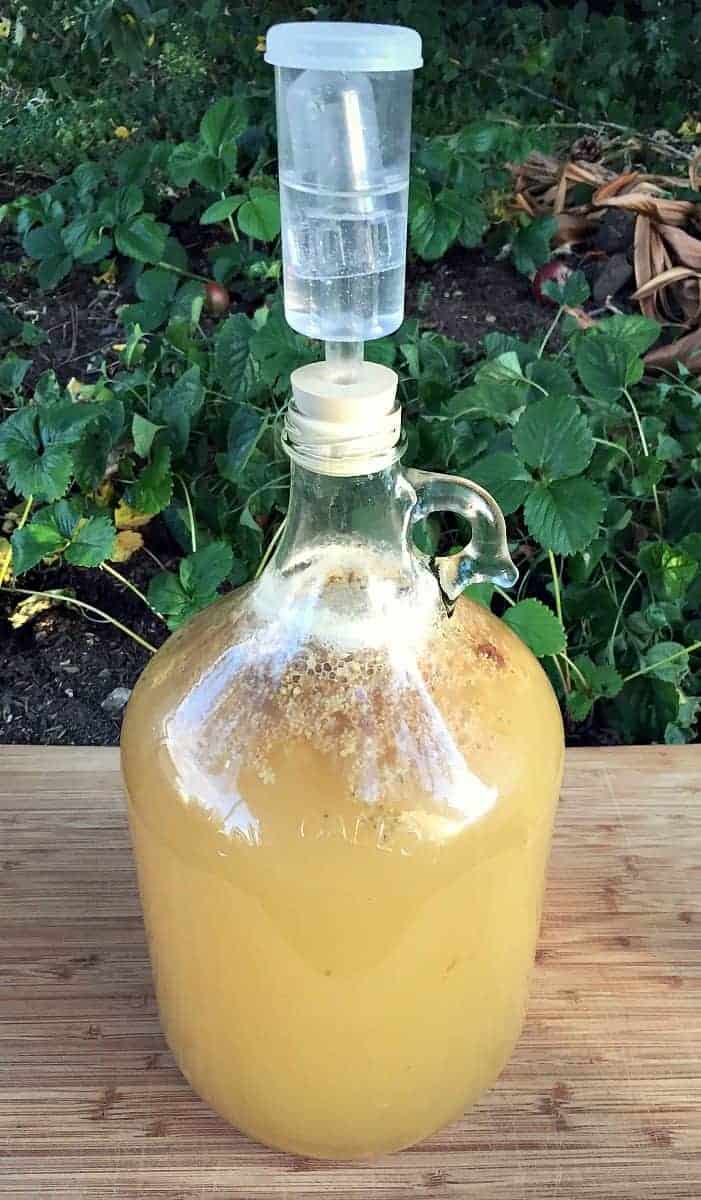
In a few hours, or overnight, you should start to see bubbles. Success!
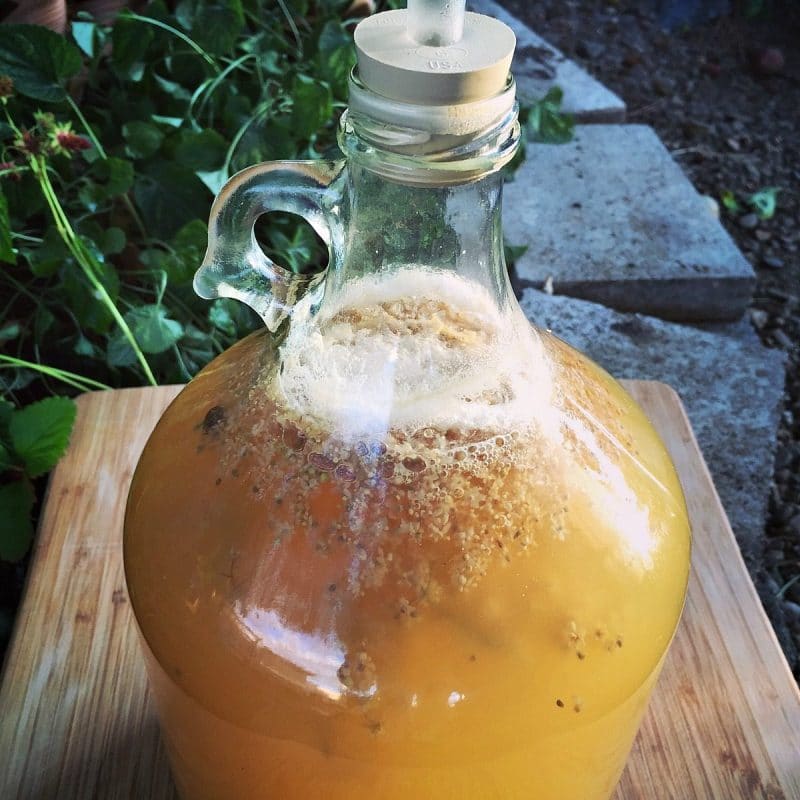
Put in a cool and dark corner of your house. Once the bubbles have almost completely stopped, it’s time to bottle.
Because of the low amount of honey I used and the warmer summer temperatures, this only took about 3 weeks.
Bottle the Elderflower Mead
Bottle the mead into swing top bottles for the best sparkling results.
My post on how to bottle hard cider is a great guide to help you with the bottling process.
Let the bottles sit for another 2-3 weeks, then enjoy your lovely elderflower sparkling mead!
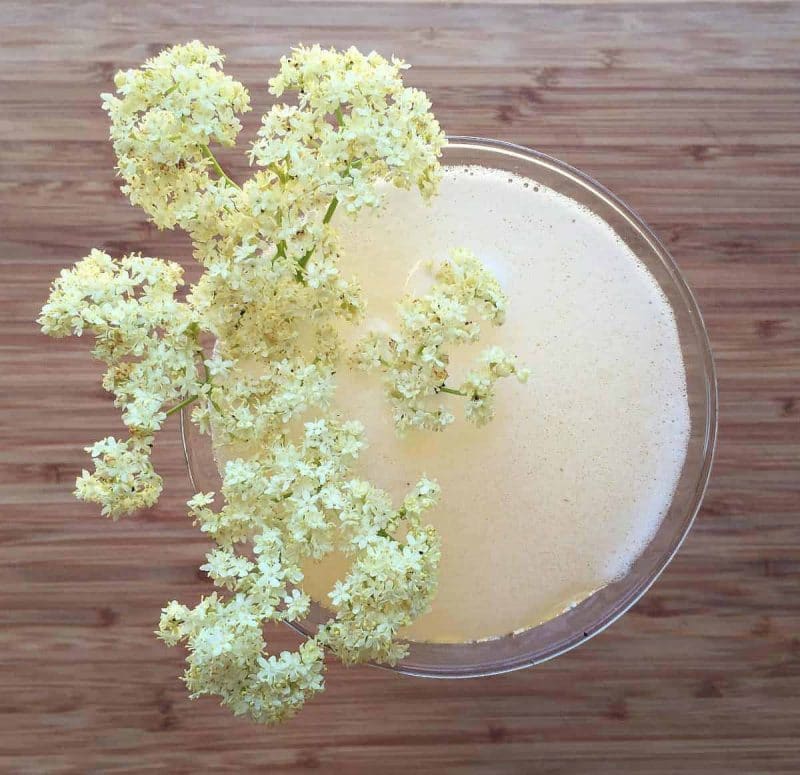
This is a refreshing, low alcohol mead, perfect for a hot summer day!
I love the subtle elderflower flavor that it has. Plus, it’s gorgeous!
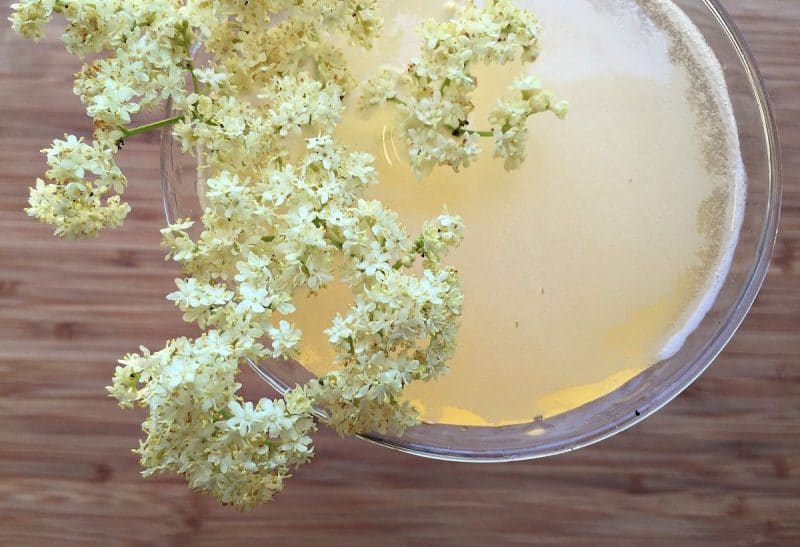
What a perfect way to kick off the summer!
Have you ever done anything fun with elderflowers?
More Mead Recipes
Ready to start brewing your next batch of mead? Here are 15 mead recipes for you to try including:
Sparkling Elderflower Mead Recipe
Equipment
Ingredients
- 6-8 elderflower heads fresh or dried
- 1-2 pounds honey
- 10 raisins
- 1 lemon juiced
- 1/2 package champagne yeast
- filtered water
Instructions
- Sanitize everything that will be used in the brewing process.
- Combine a half gallon of filtered water in a pot with the elderflowers. Bring to a boil for about 2-3 minutes, then remove from heat and steep to brew elderflower tea.
- Once the tea has cooled slightly, but is still warm, add the honey. Total amount based on taste and preference.
- Allow the tea to cool to about room temperature. Use a funnel to transfer the tea to your fermenting vessel, flowers and all. You can strain the flowers out if you wish, but leaving them in really helps get their essence.
- Add the lemon juice and raisins, then fill the jug up with cool filtered water, leaving about 3 inches of head space at the top.
- Add the champagne yeast, cap the jug, and give it a few good shakes to combine everything. Remove the cap, fill the airlock with water to the line, then place it into the jug. In a few hours, or overnight, you should start to see bubbles.
- Place the jug in a cool and dark corner of your house. Once the bubbles have almost completely stopped, it’s time to bottle. The time will be variable, 3-4 weeks based on the amount of honey used and ambient temperature.
- Bottle the mead into swing top bottles for the best sparkling results. Let the bottles sit for another 2-3 weeks, then enjoy your lovely sparkling mead!

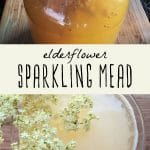
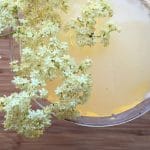

Hi there! I am wondering how the mead ends up being “sparkling” if there is no bottling sugar added. Is it the quick fermentation /// when you bottle it it is still fermenting?
I am also wondering if you have thoughts about how I could add a bit of grapefruit to the mead? Would this be possible during bottling?
Thanks so much!!
Hi Maia, yes the sparkle comes from the quick fermentation! You could add the grapefruit either before fermenting or during bottling.
I know nothing about mead. I read in an earlier comment it was a dry taste. How do I make it sweeter? I love sweet wines and sparkling things. I can not do dry. Thank you!
Hi Amanda. You can make a sweeter mead by back-sweetening.
Are they good to age longer than the two week period?
After being bottled, do the bottles need to be burped at the end of the two-three weeks? Are they good to age longer than that?
Hi, Love your site so far, have had a lot of fun harvesting the flowers this year! Just a quick question on this recipe though : Why the sanitization? Because the flowers are boiled for tea right after that part, wouldn’t the boiling sanitize them?
THx :)
Hi Dawn. Everything, not just the pot, needs to be sanitized prior to making mead to ensure it doesn’t become contaminated with pathogens that can cause your finished product to have a funky flavor.
Hi! Several recipes for sparkling mead include adding more honey during bottling to reactivate the yeast and make champagne-like bubbles. Is there a reason why I should not add additional honey while bottling?
You can definitely add additional honey before bottling to further carbonate your mead!
Is it possible to just cork this like I do with my wines? Do I need to use the swing top bottles to get the sparkle? Thanks, I’m going to start this tomorrow!!! Sounds great!!!
You can definitely use wine bottles if you’d like!
I just siphoned my mead into the swing top bottles and took a sip Just to see and it tasted flat. Will it be better after the two weeks in new bottle? This is my first time
Hi Abby. Yes, it should be. In second fermentation carbonation will build.
Hello!
I just opened the last bottle of elderflower mead that I bottled on June 14 this year. This is going to be a go-to mead, it is smooth with just a hint of sweetness but mostly dry, and I actually managed to let it sparkle this year (made a batch last year, waited to long…). It does improve with a bit of aging, this last bottle is the best of the whole batch, so I would recommend at least two months. I used a mead yeast that is supposed to produce high esters that impart a floral taste and clover honey. Thank you for this lovely recipe! Now onto elderberry mead :)
Awesome, Marit! I’m so glad you enjoyed this recipe!
Hi! I made this a few days ago but there is no bubbles Risinge like yours, just some very few. I didnt use champange yeast, only raw honey and the other ingrediens. I wanted to use more honey, but had’t any. Could it be that there is way to little honey and therefore the process is much slower, and do you recommend to add more honey now? Would be grateful with your thoughts on this and tips! Thank you 🙏🏼
I am very excited to make this! Thanks for the recipe.
How does the amount of flowers translate to dried elder flowers, by weight or volume, do you know?
I read that the stems are poisonous, but you didn’t worry about picking all the flowers off here. Thoughts? not enough to be problematic?
Once you’ve bottled it in the flip-top bottles and let it set for the additional 2-3 weeks, do you just keep it at room temp or do you refrigerate it? I’m used to Kombucha where I put it in the fridge after about 48 hours on the 2nd ferment.
hello, I’m in Alaska and all we have are Red Elderberries can I use them also, like the blue and black berries?
Hi Jacqueline, do you mean the flowers of red elderberries? I know that red elderberries are more toxic than the blue or black, but I’m guessing that the flowers are ok to use. Please do some research first, though!
I have this fermenting right now. Instead of bottling I plan on kegging it and using a beer stone for carbonation. Wish me luck. Anyone have any feedback on how theirs turned out?
Do u add more honey or sugar to the bottles to carbonate the mead? Also when I say low alcohol how low do mean? I’m hoping for about 5%
I didn’t add more honey or sugar, but you could try that. This is probably more than 5% alcohol, although I’m not totally sure how much there is. I would guess around 8%. You can use less honey to get a lower alcohol content.
Thanks for the easy recipe.Im doing it right now and so far so good. I made a similar one a couple of years ago and it was terribly good! there are many things you can do with the flowers AND berries.Many medicinal cough syrups and tonics. Elder is my favorite plant. I just seem to have an affinity with it.
I love this. I want to make mead at home so badly. I think this could be the perfect recipe for me to dive into the deep end. How can you describe the flavor of the elderflower? Does it compare to anything else you’ve tasted? Thank you for sharing this recipe! I’ll report back once i’ve made some mead myself!
I have made a variation of this recipe for a fermentation class. I am wondering if I should move it to a secondary fermenter and add more honey. I added blackberries and Meyer lemon to the primary fermenter, and I am a little worried the pH will be off.
Any advice would be appreciated.
You can move it to a secondary fermenter if you’d like, but I don’t think it’s absolutely necessary. I generally keep my meads pretty simple and don’t worry about things like pH. I’ve always had good results!
Quick question, I’m a total mead novice and so was wondering why the addition of the lime juice? I get the raisins giving the yeast nutrients. Just unsure about lime juice. Does it help cut the sweetness? How would it be different without it?
Thank you!
I just planted 2 elderberry bushes this year, an Adam’s and a John’s. The John’s has 6 or 7 flower heads on it already and the Adam’s has 2 or 3. I had no idea you could make something so lovely as this from the blossoms, but I’m saving this recipe and would love to try it next year! I think being that the bushes are just in their first year I’ll let them run their natural cycle and produce the berries. I expect they’ll be much bigger and heartier next season and then it’s game on! Thank you for the recipe, love your blog!
Hello! I was curious about cultivating this plant. I would love to have a few on the land. Any ideas about cultivation?
I bought plants from a seed catalog. Two varieties are needed to cross pollinate. Plants should be planted 8 feet apart! They get huge and spread to fill in the space between them. They send out plenty of side shoots underground that can be dug out and used to cultivate additional plantings. If you buy plants just get one of each variety as you will be able to start additional plants from cuttings after the first years growth.
Nice! I made strawberry mead a few weeks ago. I used cold stirred honey, so the live yeast in the honey was still alive, and did not add any addition yest, so the wild yeast in the honey and strawberries did all the work! Great success!
This sound wonderful. I have dried elderflowers I have been saving for something special…this sounds like just what I was looking for!
I am so excited to make Elder Flower Mead. I even saved some honey to make it. But, alas, it got too hot here in my South Texas kitchen and to ferment mead until the fall. So… I’m drying my flowers to use this fall in my first fall mead.
Thanks so much for all your great posts regarding mead. I use Sandor Katz’s method to attract wild yeast here since my house is not air conditioned and is open to the elements. I’ve always had great results whether making plain mead or any of my herbal or fruit meads.
I don’t make mead when the temps reach above about 75 F in the house. The yeasts turn funky and the brew can turn into something very unpleasant.
If anyone has any suggestions about making mead with wild yeasts in the terrific heat of a south Texas summer, I’d love to hear about it.